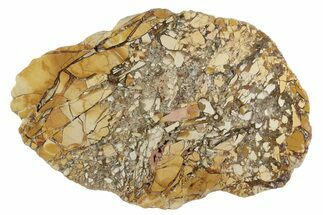9.1" Polished Mookaite Jasper Slab - Australia
This is a gorgeous, 9.1" wide, polished slab of vibrantly colored mookaite. One side has been polished to a glossy finish and it's accompanied by an acrylic display stand.
About Mookaite Jasper
Mookaite jasper is a stunning, multi-colored stone with vibrant hues of reds, yellow and purples, formed from the fossilized remains of microscopic radiolarians. It is found in the 110 million-year-old Windalia Radiolarite formation, which formed on a shallow, marine shelf. Mookaite is found as vibrantly colored nodules in certain beds of soft white clay within the formation.
Radiolarite is a fine-grained, chert-like sedimentary rock composed predominantly of the microscopic remains of radiolarians. Radiolaria are tiny (100 micrometers!), free-floating, zooplankton that produce intricate mineral skeletons made of silica. When the radiolarians died, their tiny silica based skeletons settled on the bottom of the ocean and became covered in sediments like mud and clay.
As this sediment turned to sedimentary rock in a process known as diagenesis, the silica from the radiolarian skeletons pinched and coagulated into ribbons, nodules and other irregular concretions. These ribbons, nodules, and concretions are the mookaite within the clay layers. The coloration is due to other (mostly iron based) mineral impurities present along with the silica. Thus, mookaite can be considered as a fossiliferous sedimentary rock made out of the tiny skeletons of radiolarians.
Mookaite jasper is a stunning, multi-colored stone with vibrant hues of reds, yellow and purples, formed from the fossilized remains of microscopic radiolarians. It is found in the 110 million-year-old Windalia Radiolarite formation, which formed on a shallow, marine shelf. Mookaite is found as vibrantly colored nodules in certain beds of soft white clay within the formation.
Radiolarite is a fine-grained, chert-like sedimentary rock composed predominantly of the microscopic remains of radiolarians. Radiolaria are tiny (100 micrometers!), free-floating, zooplankton that produce intricate mineral skeletons made of silica. When the radiolarians died, their tiny silica based skeletons settled on the bottom of the ocean and became covered in sediments like mud and clay.
As this sediment turned to sedimentary rock in a process known as diagenesis, the silica from the radiolarian skeletons pinched and coagulated into ribbons, nodules and other irregular concretions. These ribbons, nodules, and concretions are the mookaite within the clay layers. The coloration is due to other (mostly iron based) mineral impurities present along with the silica. Thus, mookaite can be considered as a fossiliferous sedimentary rock made out of the tiny skeletons of radiolarians.
About Jasper
Jasper is a term that can be applied to an opaque variety of chalcedony. The opaqueness is due to a higher concentration of impurities mixed with silica/quartz compared to other varieties of silica, such as quartz or agates. Like agate it may form in a wide variety of colors, and is often multi-colored. In most cases, jasper forms when silica-rich fluids permeate throughout a soft sediment or volcanic debris deposit. The fluids then crystallize around the particles/impurities, resulting in a cementation process. Most often, the impurities present determine the coloration of the deposit following solidification, but other factors can play a role in the color of what is now considered a jasper.
Jasper is a term that can be applied to an opaque variety of chalcedony. The opaqueness is due to a higher concentration of impurities mixed with silica/quartz compared to other varieties of silica, such as quartz or agates. Like agate it may form in a wide variety of colors, and is often multi-colored. In most cases, jasper forms when silica-rich fluids permeate throughout a soft sediment or volcanic debris deposit. The fluids then crystallize around the particles/impurities, resulting in a cementation process. Most often, the impurities present determine the coloration of the deposit following solidification, but other factors can play a role in the color of what is now considered a jasper.
SPECIES
Chalcedony var. Jasper
LOCATION
Mooka Creek, Gascoyne Junction, Western Australia
FORMATION
Windalia Radiolarite
SIZE
9.1 x 5.1", .35" thick
CATEGORY
SUB CATEGORY
ITEM
#221870
 Reviews
Reviews










